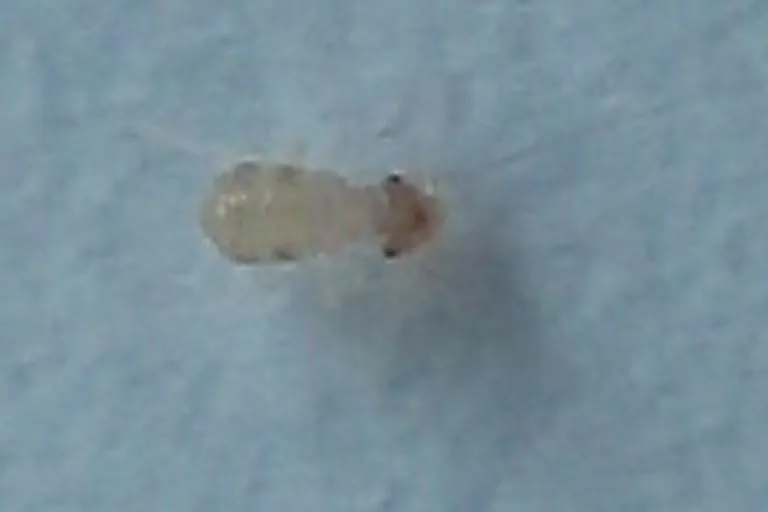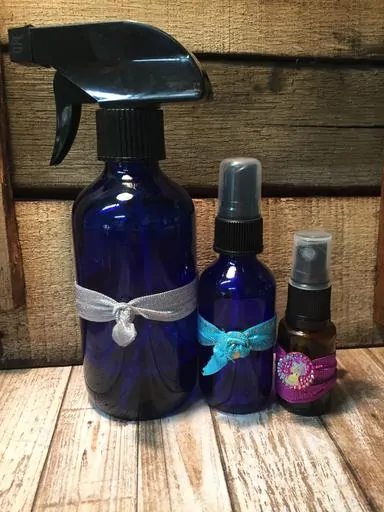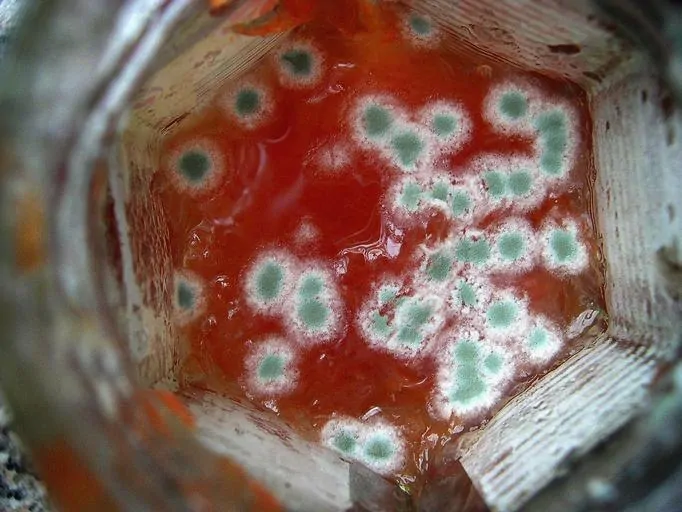Book lice certainly sound horrible, but the good news is that they are not true lice and they don’t suck blood, get into your hair, or cause any harm to people or pets. Unfortunately, an infestation of book lice is still nothing to ignore.
These tiny pests can reproduce rapidly and cause serious damage to property and sometimes even structures if not handled the right way.
So, how do you manage a book like infestation and keep these tiny insects from returning in the future?
Keep reading to find out.
Contents
What Are Book Lice?
Booklice are small insects that feed primarily on mold and fungi.
Common throughout the United States and even the world, book lice (aka Liposcelididae) are small, crawling insects that grow to be around 1/16th of an inch in length. Also known as Psocids, paper mites, book mites, book bugs, or barklice, book lice are generally white or a pale tan, have six legs and three sectioned body parts. Book lice do not have wings and cannot fly.
Though you might come across book lice nearly anywhere in the United States, they are most common in the Southern regions of the US where humidity is high and thus their food source is more abundant.
Book lice tend to invade homes and gardens and can infiltrate pantries, book shelves, crops, and even furniture.
In small numbers, book lice are not as problematic as some other pests in the home. However, in large numbers they can cost you hundreds of dollars in waste, property damage, and pest management fees.
Worse, their presence could mean you have an underlying mold or mildew issue in your home that could be dangerous to your health and the health of your loved ones.
So, how can you tell if you have book lice? Let’s find out.
How To Identify Book Lice
Usually the first sign of a book lice infestation is the physical sighting of an actual booklouse.
Book lice begin small, with their eggs actually invisible to the naked eye. Once born, book lice go through three stages including egg, nymph and adulthood. Baby book lice look exactly like their adult counterparts, just smaller.
Book lice reproduce quite rapidly, with one female book louse able to lay up to 60 eggs in the summer months, and it takes around a month for book lice to reach adulthood. Once mature, book lice live for another two months.
Adult book lice are commonly confused for other pests including ticks, bed bugs and even termites. However, they are actually much less damaging or dangerous than the three most common pests they are mistaken for, which is always a relief for homeowners who come across them.
But how do you know if you’re dealing with book lice and not a more sinister imposter? It’s easy.
Book lice, as mentioned above, are small and pale. They do not have wings and do not jump, but often scuttle quickly to find hiding spots when disturbed. Book lice also have very particular living conditions and can be found hiding in book shelves, in the creases of furniture, and in storage areas where organic matter like books, cloth and plaster have not been properly stored.
Finding book lice in the early stages of an infestation can be complicated unless you know exactly what to look for.
You may have book lice in your home if you notice:
- A booklouse sighting
- Deterioration of books, paper, or plaster
- Book lice in cereal boxes or pantry foods
- Book lice beneath peeling wall paper or other paper products
- Book lice in storage boxes made of cardboard
You may have book lice in your yard or garden if you notice:
- Book lice congregating along your window sills
- Book lice beneath tree trunks
- Book lice hiding in shrubs or flowers
- Garden hoses or gutters surrounded by book lice
- Book lice beneath rocks, bricks or flower pots
- Book lice surrounding light fixtures
- Silk-like webbing around tree trunks and tree branches
What Attracts Book Lice?
Booklice are especially attracted to mold and glue on paper products like antique books.
Book lice are attracted to sources of moisture above all else. They not only need water to survive, but the high levels of moisture and humidity also make it possible for them to feed. This is why the Southern part of the United States, where the weather is often much more humid, is more notorious for book lice problems.
In spite of their name, book lice don’t actually eat books. Instead, they eat the mold that grows on the books’ pages as well as the glue bindings of these books and other items. Book lice primarily dine on mold and fungi, which can accumulate both inside and outside of homes, but they also feed on grains, starches, decaying plants, and other dead insects.
In the home, book lice thrive on humidity levels of above 50-60% and in warmer climates with weather between 75 and 82 degrees Ferenhite. In these conditions, it’s very simple for mold and fungi to accumulate and grow, especially if clutter is left unattended for long periods of time or certain items are stored improperly.
Inside, book lice are attracted to:
- Antique books and documents
- Newspapers
- Printer paper
- Magazines
- Notebooks
- Pantry liners
- Shelving liners
- Improperly stored pantry foods like cereal and grains
- Wall paper
- Cardboard
- And wet plaster (often found in new construction)
Outside, book lice are attracted to:
- Debris
- Decaying wood material
- Flowerpots
- Leaf litter
- Water hoses
- Drains
- And gutters
The below video discusses more about what Book Lice are attracted to.
<iframe width=”560″ height=”315″ src=”https://www.youtube.com/embed/fOgTVoEwdwc” frameborder=”0″ allow=”accelerometer; autoplay; clipboard-write; encrypted-media; gyroscope; picture-in-picture” allowfullscreen></iframe>
So, now that you’ve properly identified book lice, let’s go over a few of the best methods you can use to get rid of them.
How To Get Rid Of Book Lice Using Natural Methods
Food grade diatomaceous earth is a safe and effective way to get rid of book lice.
For the most part, getting rid of book lice is as simple as reducing humidity and tossing out any infested items in the home. However, larger infestations may require the use of commercial products.
When it comes to book lice, there are plenty of natural products you can purchase and use to eliminate these pests without the use of harsh chemicals or insecticides. This is great news if you are passionate about organic pest control or if you have children or pets in the home.
That said, it’s important to make sure you purchase the right products that are designed for crawling insects like book lice. We should also note that, on occasion, natural methods of pest control can be costlier than the use of insecticides and may sometimes require more maintenance and repetition.
Still, using natural methods is always safer for people, pets and the environment and can work just as effectively in the long run for getting rid of pests like book lice when applied correctly.
Let’s take a look at some of our favorite natural products you can use for book lice control below.
Diatomaceous Earth
No products found.
Also known as DE, Diatomaceous Earth is an all natural dust insecticide made from fossilized algae. It works by penetrating an insect’s exoskeleton, which then dehydrates and kills it. DE can be used safely inside and outside and is completely harmless to people, pets and the environment.
Best of all, due to its unique dehydrating qualities, DE is highly effective on pests like booklice. You can use this dust along book shelves, in bathrooms, basements, crawl spaces, and even in kitchen pantries and cabinets.
Remember that DE works best when dry, so if it gets wet it should be vacuumed up and reapplied. Diatomaceous Earth also works on a number of other pests including bed bugs, roaches, beetles, spiders, and ants.
Safer Ant and Crawling Insect Killer
No products found.
Another product that contains Diatomaceous Earth as an active ingredient is Safer Crawling Insect Killer. This order comes in a smaller, easy to use spouted container that is designed to specifically spot treat certain areas.
We like this product for creating barriers around items in the home like bookshelves and pantry foods. It is again safe for people and pets, and will not harm the environment. You can use it inside and out and even directly on garden plants and vegetation.
Eco Defense Home Pest Control Spray
No products found.
The above natural pest control spray uses plant-based ingredients to kill and repel a number of pests like book lice, roaches, spiders, mites, silverfish, stink bugs and fleas. It is for use inside the home and is designed as a spot treatment spray for specific areas, making it ideal for a book lice infestation.
It works immediately upon contact and continues to last for long periods while you clean and throw out any infested items or foods.
Wondercide Outdoor Perimeter Spray
No products found.
This spray by Wondercide uses essential oils to repel and kill pests like book lice, making it safe and effective. It is also an all natural way to provide the inside and outside of your home with long-lasting protecting. You can spray Wondercide around the perimeter of your home to prevent future booklice from getting inside and even spray it directly on plants.
This spray also gets rid of other pests like spiders, roaches, ticks, fles, mosquitoes and more. It is also perfectly safe to use in areas where children and pets play.
How To Get Rid Of Book Lice Using Insecticides
Because booklice often infest home spaces like bookshelves, it’s important to use insecticides carefully.
Most insecticides that are meant to eradicate crawling insects should work just fine when it comes to getting rid of book lice inside and outside of the home.
That said, most book lice do not cause problems outside of the home and are actually beneficial insects as they are natural decomposers. However, inside they can be a nuisance, and a very large infestation may require more intensive treatments if natural products do not work.
However, keep in mind that most insecticides contain harsh chemical ingredients that can be toxic to people, pets and the environment. Insecticides should always be used responsibly and only as directed.
Are you wondering what the best insecticides would be for book lice control inside of your home? Take a look below.
Ortho Home Defense Max Indoor Spray
No products found.
Ortho is a trusted insecticide and pest control brand that many people have found effective against pests like book lice. It works well to also eliminate other crawling insects like spiders, ants, and roaches.
The product is designed for indoor use and can kill and prevent future pests for up to a year after application. That said, the active ingredient is Bifentrhin, which is a toxic insecticide chemical that can be dangerous for people and pets. Use this product only as directed and keep it out of reach of children.
Southern AG Pyrethrin Concentrate
No products found.
Though Pyrethrin is a natural chemical compound derived from chrysanthemums, it can still be toxic to people and pets and should be used with caution. Still, this is a safer alternative to using chemical insecticides in the home when dealing with book lice.
Any insecticide containing pyrethrin should be effective against these pests and many others including mosquitoes, roaches, spiders, fleas and even ticks. The above product has multiple uses and can be used inside and out. That said, it comes in a concentrate and will need to be diluted before use.
How To Get Rid Of Book Lice Using Home Remedies
You can easily make your own book lice repellent sprays and cleaning products using essential oils and vinegar.
Many people prefer to try their hand at home remedies for book lice control and for good reason. Do it yourself pest control methods are often more convenient, safer, and even less expensive than purchasing products online or at the store.
Best of all, many of these DIY methods are highly effective. When it comes to book lice, who are so heavily reliant on water and humidity to survive, using home remedies to get rid of them may be more simple than you realise.
Let’s take a look at some of the household ingredients you likely already have in your home that you can use to get rid of these annoying pests for good.
Use Essential Oils
Many people find that essential oils work wonders for natural pest control, and this is no exception when it comes to book lice. The strong smell of most essential oils can help repel book lice and keep them from returning in the future.
The below essential oils are some of the most highly recommended for book lice control, according to experts.
- Neem Oil
- Peppermint Oil
- Tea Tree Oil
- Lavender OIl
- Cedar Oil
You can use the essential oils above in a few different ways for booklice control, with the first being to saturate cotton balls in the oil of your choice. Leave these cotton balls around your home, on bookshelves, in attics, basements, crawl spaces, and anywhere else you have noticed or would like to repel book lice. You should replace these cotton balls with freshly soaked ones every two to three days.
You can also make your own essential oil book lice repellent spray. Simply add 10 to 20 drops of the essential oil of your choice to one cup of water in a spray bottle and lightly spray around your home as often as needed to repel and prevent book lice. This can even help repel other pests like bed bugs, spiders, mites, roaches, and ants.
Use A Dehumidifier
Book lice will quickly die in homes that have below 50% humidity, so one of the most effective ways to get rid of them is to use a dehumidifier. This is a simple process you can use and continue to use to kill and then prevent future book lice.
Use A Vacuum
If you have found book lice living in your home, chances are they are congregating in particular spots where moisture, mold and fungi are abundant. Once you have cleared the area of debris, you should use a vacuum to clean up any remaining book lice. Dispose of the contents in the vacuum bag in an airtight trash bag and put it outside.
Use Hydrogen Peroxide
Hydrogen peroxide is naturally drying and makes for an excellent cleaning and killing agent when it comes to book lice. You can use pure hydrogen peroxide as is on a rag or towel to wipe down surfaces and kill any book lice or book lice eggs.
However, keep in mind that hydrogen peroxide can be destructive to fragile possessions, especially paper products like antique books, so use this method with caution.
Toss Infested Items and Foods
It is certainly best to toss any foods infested with book lice as this is a clear sign food has grown mold, even if you can’t see the mold with your naked eye. Items like books and other paper products should also be tossed out, especially if they are greatly damaged.
Unfortunately, you cannot undo damage that has been done by book lice, and the easiest way to rid yourself of book lice is to get rid of the item altogether. Of course, if the item in question is particularly valuable, you can always store it safely in a bag or plastic tote and bring it to a professional to have it cleaned and repaired as best as possible.
Use Talcum Powder or Baby Powder
Any type of drying powder like talcum powder or baby powder can help kill and prevent future book lice. This is also a great way to protect valuables from book lice in the future. Simply sprinkle this powder along book shelves and over books, in cabinets and pantries, and along window sills where book lice are likely to enter your home.
Use Soap and Water To Wipe Down Surfaces
Soap and water is a simple and effective cleaning method you can use to wipe down surfaces and get rid of book lice and their eggs. Clean surfaces thoroughly including book shelves, pantries, cabinets, and window sills to kill and repel book lice.
Make Your Own Vinegar Cleaning Spray
The strong smell of vinegar repels a number of pests including book lice, ants, roaches, and even rodents. You can mix equal parts vinegar and water in a spray bottle and use it to wipe down surfaces in kitchens, bathrooms, bedrooms and anywhere else throughout the house safely and effectively.
Are Book Lice Dangerous?
Booklice are not dangerous, but the mold that attracts them to your home could be.
While book lice themselves are not dangerous to people or pets, their presence in your home could be a sign of something particularly hazardous – mold.
Since book lice primarily feed on mold and are attracted to areas high in moisture, a large accumulation of book lice inside your home could mean you also have lots of mold. Mold can be incredibly dangerous to people and pets and cause a slew of health issues from increased allergies to chronic respiratory problems.
Furthermore, the presence of book lice in food is a sign the food has gone bad and should not be consumed.
If you have worked to get rid of book lice and find that you cannot solve the issue or find the source of the infestation, it’s a good idea to contact a professional pest control expert. Professionals should be able to help you sort out the core issue, get rid of the book lice, and go over ways to prevent a future book lice infestation in the future.
How To Prevent Book Lice In the Future
Caulk and seal entry and exit points and reduce excess humidity in your home to prevent and repel booklice.
If you manage to eradicate mold and fungus in your home, you should be able to keep book lice at bay while also protecting your family and loved ones.
Here are a few steps you can take to prevent future book lice in your home:
Keep Your Home Clean and Reduce Debris
Reducing clutter and debris in and around your home can reduce the chances of mold, fungi, and other organic matter from building up and attracting book lice. Try and remove any unnecessary storage items and keep anything you wish to store in plastic tote containers as opposed to cardboard boxes.
We also suggest keeping your yard and landscaping neat and tidy to reduce book lice form accumulating outside as well.
Remove Unused Paper Products
Remove any unused paper products immediately. This includes cardboard, computer paper, magazines, books, old wall paper, etc. Or, if you wish to keep these items, store them in air-tight plastic totes.
Store Pantry Food In Air-Tight Storage Containers
Along with storing paper products in air-tight totes, it’s also best to store pantry foods like grains and cereals in air tight containers as well. Plastic or glass are typically best, and will not only help keep moisture and mold out, but also pests like book lice, roaches, ants, and rodents.
Reduce Excess Humidity Around The Home
Make sure air vents are properly cleaned and unblocked throughout the home to ensure your home has good ventilation. We also suggest investing in a dehumidifier, especially if you live in areas with high levels of humidity year-round.
Caulk and Seal Potential Entry Points Around The Home
Book lice and many other pests find their way inside through vulnarbilities outside your home. You can help prevent future book lice by caulking and sealing cracks and crevices around your perimeter, making sure screens are properly fitted and free of tears, and ensuring there are not any gaps along doorways.
Repair Any Water Damage And Dry Leaks Immediately
Do not let water damage sit to the point it can begin to develop mold or fungus. Instead, clean it immediately and dry it as much as possible. It’s also best to repair any water damage or leaks you notice as soon as you come across them.
Use A Routine Pest Control Regime Year Round
Using a routine pest control regime year round can help protect the inside and outside of your home from a variety of pests, not just book lice.
And remember, while book lice are not dangerous, their presence is certainly a red flag. Don’t delay on book lice control and prevention, and keep your eyes peeled for signs of these critters throughout the year.
Best of luck and thanks for reading!


Jack founded our blog after two decades of working in the pest control industry. His vast experience dealing with a wide array of pests allows him to diagnose issues quickly and get to the heart of pest problems quickly and effectively. He has serviced more than 2,000 homes over his career and there is hardly any pest situation that he has not seen before.








